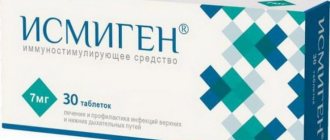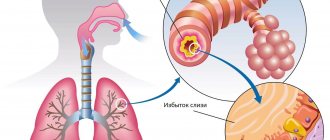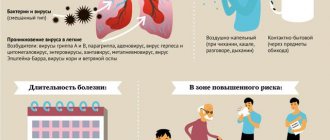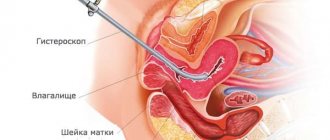From the time of infection with acute respiratory viral infection (ARVI) to the appearance of symptoms of the disease, a period of time passes, which is called the incubation period. The duration of this time interval depends on the type of infection and the state of the person’s immunity.
- What is the difference between ARVI and ARI
- Incubation period in adults For adenovirus infection
- For respiratory syncytial infection
- For rhinovirus infection
ARVI and acute respiratory infections: what is the difference
First, let's understand the terms. ARVI is an acute respiratory viral infection that can be caused by a large number of different viruses. ARI – acute respiratory diseases. Previously, this was the designation for all respiratory diseases of both a viral and viral-bacterial nature. And ARI (acute respiratory infections) is a term that replaced acute respiratory infections. These infections can also be caused by viruses and bacteria. There is no big difference between the presented groups of diseases. One abbreviation assumes that the causative agents of diseases are only viruses, which is what happens in most cases; another name does not exclude a bacterial component. Clinically, these infections are very similar, which made it possible to combine them into groups.
When do outbreaks of acute respiratory infections occur?
As a rule, an increase in the incidence of ARVI and ARI is observed in the cold season, and the prevalence of infection is widespread - colds and flu are familiar firsthand not only to children, but also to adults in all countries of the world. According to WHO, during periods of peak incidence, these infections are diagnosed in almost 30% of the world's population.
But any cold and flu viruses that have entered the human body do not immediately make themselves felt. There are many varieties of acute respiratory viral infections, the type of which determines the timing of the development of clinical symptoms when a person realizes that he is sick. Runny nose, cough, sore throat and other similar symptoms can be caused by various types of influenza viruses, parainfluenza, adenoviruses, rhinoviruses, reoviruses, ECHO and Coxsackie viruses.
What to do first when symptoms appear
The first and most important thing is self-isolation. If symptoms of Covid are detected, it is necessary to limit contact as much as possible and inform your family doctor about the symptoms. He will order a COVID-19 test to ensure the presence or absence of infection. If Covid is confirmed, the doctor will select treatment tactics, and the carrier will need to remain in quarantine for the prescribed time. Self-isolation ends when you take the test again with a negative result.
Other important recommendations for those exposed to coronavirus:
- try to get plenty of rest so that your body has the strength to fight the disease;
- eat a healthy diet and drink enough fluids;
- follow the correct daily routine;
- Monitor the humidity in the room so that it always remains at the optimal level.
And be sure to follow all doctor's instructions.
Incubation period of acute respiratory infections / acute respiratory viral infections in adults
Acute respiratory viral infections share common features, which include an acute onset of the disease with elevated body temperature, signs of intoxication, catarrhal symptoms and an incubation period that lasts on average about a week. But still, different viruses have different “preparatory” periods.
Adenovirus infection
The adenovirus can make itself felt both 2 days after infection and 10-12. In this case, everything will depend on the initial state of the patient’s immunity. The onset of the disease is acute, the temperature immediately rises, profuse nasal discharge, and a wet cough with clear sputum appear. The mucous membrane of the nose, pharynx and tonsils swells, and the lymph nodes become enlarged. Later, signs of bronchitis and laryngitis may appear. Conjunctivitis may also be a concern.
The course of the disease is usually long-term and can be undulating due to the constant proliferation of viruses and the emergence of new foci of infection. In some cases, even after recovery, a person remains a carrier of an adenovirus, which can occupy the tonsils and remain there in a latent state.
Respiratory syncytial infection
The incubation period for this infection ranges from two days to a week. There is a runny nose, pain when swallowing, and the body temperature in adults most often does not increase, but may be low-grade. The onset of the disease is usually gradual, with scanty nasal discharge, a red pharynx, and as the inflammatory process develops, a dry cough appears with the release of viscous sputum.
Respiratory syncytial infection can invade the airways and lead to respiratory failure, shortness of breath, wheezing, and noisy breathing. It is possible to develop apnea, a pathological process that leads to cessation of breathing during sleep. Mild and moderate forms of the disease usually last 7-10 days, severe ones - up to two weeks or more. Lack of treatment and a weak immune system can lead to recurrence of the infection.
Rhinovirus infection
This disease has one of the shortest incubation periods - it takes only 2-3 days. In rare cases, it lasts up to a week. This disease is not characterized by intoxication and elevated body temperature in adults. The infection is usually accompanied by a profuse runny nose and dry cough. Watery eyes and irritation of the eyelid mucosa may also occur.
Prevention of STDs
Prevention of STDs plays a fundamental role in preventing the occurrence of sexually transmitted diseases. The main preventative measure to avoid infection is safe sex using condoms. However, it is worth noting that this method of contraception cannot be called 100% protection, so sexually active people should adhere to the following recommendations:
- refuse casual sexual contacts;
- limit the number of sexual partners;
- observe the rules of personal hygiene and do not use other people’s hygiene items in public places;
- undergo preventive examinations for HIV, syphilis, hepatitis - even in the absence of symptoms of STDs (every six months for women and once a year for men);
- use the services of cosmetologists, manicures, and tattoos only in trusted institutions.
It is extremely important to consult a doctor immediately if you notice any changes in your health after unprotected sexual intercourse. If you are looking for a good doctor, the specialists of the Euromedprestige clinic are ready to provide qualified medical care and prescribe competent treatment for diseases with a guarantee of complete recovery.
How long is the incubation period of ARVI in children from one to 3 years old?
With ARVI in young children, a more severe course and deeper penetration of viruses are observed. On average, the period after which signs of the disease begin to appear in children when infected with acute respiratory viral infections is shorter than in adults, which is associated with the characteristics of the immune system, as well as with the structure of the organs of the respiratory system: their larynx is shorter than that of adults.
For example, parainfluenza manifests itself after only 2-4 days, and the onset is violent, with a sharp increase in body temperature and obvious signs of intoxication. The voice becomes hoarse, the child complains of a sore throat, and is bothered by a cough. Body temperature rises to 38ºC and above. In children aged one to three years, infection can lead to the development of false croup - acute laryngeal stenosis. Symptoms of this disease include a barking cough, a wheezing voice, and noisy breathing. Also, young children may develop obstructive bronchitis and other complications that require immediate medical attention.
The main difference between parainfluenza and influenza is that parainfluenza does not cause large epidemic outbreaks. The influenza epidemic develops quite acutely, since the incubation period for influenza is even shorter - 12-24 hours.
With adenovirus infection, children under two years of age may experience not only catarrhal symptoms, but also abdominal symptoms - diarrhea and abdominal pain. Also, a sick child may experience decreased appetite, sleep disturbances, pale skin and a bluish discoloration of the nasolabial triangle.
In order to prevent the development of complications, it is necessary to seek help from specialists at the first signs of the disease.
How likely is it to die from coronavirus?
It's important to remember that even if you have a moderate or severe coronavirus infection and require hospitalization, most people are much more than to die from coronavirus.
The model, based on an analysis of coronavirus mortality statistics based on data from 37 countries, states that the mortality rate was about 1.4% for people under 60, 1 in 15 for all people over 60 and 1 in 7 of the sick are over 80 years of age.
Another article reinforces the idea that your risk of dying, even if you end up in hospital, depends largely on your age. Although a significant number of people who require intensive care will not recover, the rate of recovery for people who do not require mechanical ventilation is favorable.
The percentage of people infected with coronavirus who require intensive care is:
- up to 40 years - 5%.
- 40-49 years old - 6.3%.
- 50-59 years old – 12.2%
- 60-69 years old - 27.4%.
- 70-79 years old – 43.2%
- Over 80 years old – 70.9%.
Incubation period of acute respiratory infections and influenza in older children
In older children, the incubation period for infection with acute respiratory viral infections is in most cases the same as in adults - from one or two days to a week or more. The duration of the disease in children is usually at least 10-12 days. Sometimes relapses are possible, which especially often happens with the addition of a bacterial infection and the development of otitis media, sinusitis, bronchitis and pneumonia. A runny nose causes damage to the skin around the nasal passages, making it painful for the child to blow his nose. There is also a risk of herpetic rashes in the area of the nasolabial triangle, lacrimation and loss of smell and taste.
In children under 5-6 years of age, acute respiratory viral infections can lead to febrile seizures - convulsive attacks against the background of elevated body temperature. Infections can also cause complications in the form of diseases of the cardiovascular, excretory, nervous systems and exacerbation of existing somatic diseases.
Causes of STDs
The main route of infection with sexually transmitted diseases is predominantly sexual. If sexual intimacy occurs without the use of contraception, then the probability of infection is virtually 100%. The mucous membrane in the genital area is a favorable environment for the proliferation of microorganisms and attracts them with a comfortable temperature and high humidity.
When they get on the mucous membrane, infections attach to its surface and begin to multiply quickly, displacing healthy microflora over time. As STDs develop, the pH level of the skin becomes more alkaline or acidic, resulting in additional infections being added to the underlying pathology. Usually these are colpitis, prostatitis, bacterial vaginosis, cervical erosion.
In addition to sexual contact, there are numerous cases of infection through domestic means. A person can get sick when visiting public places or after using other people's personal hygiene items. Some pathologies can be transmitted through blood (for example, through a syringe), as well as from mother to child during childbirth or breastfeeding.
Antiviral drug VIFERON
In children, the level of antiviral protection is significantly lower than in adults. This is primarily determined by the low ability of leukocytes and lymphocytes to induce their own interferons - proteins with similar properties, secreted by body cells in response to virus invasion. This, among other reasons, explains the predisposition of the child’s body to frequent ARVI. Antiviral drugs can compensate for this feature. When treating children, special attention should be paid to antiviral drugs, which cover the entire etiological spectrum of acute respiratory infections, including influenza.
The obvious advantages of drugs containing interferon over other antiviral drugs is their high non-selective antiviral activity. This means that such drugs are able to fight all types of acute respiratory viral infections, without additional tests or specifying the strain of the influenza virus.
To prevent undesirable consequences of acute respiratory viral infections in a child, in consultation with a doctor, you can use the antiviral drug VIFERON Suppositories.
It can be used to treat children from the first days of life and expectant mothers from the 14th week of pregnancy.1
How do VIFERON Candles work?
The drug VIFERON Suppositories (suppositories) contains human recombinant interferon alpha-2b and has antiviral and immunomodulatory properties. It prevents the multiplication of the virus in the human body, which ensures the prevention and treatment of viral and other diseases.
Since the drug VIFERON Suppositories (suppositories) has a wide spectrum of antiviral activity, it is a universal remedy against influenza and ARVI. This drug helps fight infection at any stage of the disease. VIFERON provides a powerful antiviral effect and allows you to shorten the overall duration of the disease, quickly cope with the manifestations of infection (runny nose, cough, weakness, fever, etc.), and also reduces the likelihood of developing complications and subsequent diseases. 2
You can also use the drugs VIFERON Gel and VIFERON Ointment to treat children.
For the treatment of ARVI in children from 1 year to 2 years old, VIFERON Ointment 2500 IU (1 pea with a diameter of 0.5 cm) is used 3 times a day, for children from 2 to 12 years old - ointment 2500 IU (1 pea with a diameter of 0.5 cm) 3 times a day. .5 cm) 4 times a day, for children from 12 to 18 years old - ointment 5000 IU (1 pea with a diameter of 1 cm) 4 times a day. The duration of treatment is 5 days.
VIFERON Gel can be used for the prevention and treatment of children from the first days of life. In order to protect your child from colds and flu, it is necessary to apply a strip of gel approximately 0.5 cm long to the nasal mucosa 2 times a day as a preventive measure. Course duration is 2-4 weeks. For the treatment of ARVI, including influenza, including those complicated by a bacterial infection, the application of VIFERON gel must be repeated 3-5 times a day for 5 days.
Reference and information material
Author of the article
Belyaev Dmitry Alexandrovich
General doctor
- VIFERON Suppositories are approved for use by children from the first days of life and pregnant women from the 14th week of pregnancy, VIFERON Gel - by children from the first days of life, there are no restrictions for use during pregnancy, VIFERON Ointment - from 1 year, there are no restrictions for use during pregnancy.
- Nesterova I.V. “Interferon drugs in clinical practice: when and how,” “Attending Physician,” September 2021.
Loading...
Take other surveys
Diagnosis of STDs
In many cases, diagnosing STDs requires a comprehensive approach using several different research techniques. Identification of diseases in our clinic begins with an examination and preliminary interview of the patient. The doctor asks about complaints, collects anamnesis, determines the severity of symptoms and how long ago they appeared. Based on the data obtained, the person is sent for laboratory tests to confirm the preliminary diagnosis.
Most often, diagnostic measures include the following tests:
- Smear microscopy - helps to identify inflammatory processes and detect pathologies such as trichomoniasis, mycosis, bacterial vaginosis.
- Cultural seeding is carried out in a bacteriological laboratory and consists of applying material to a nutrient surface. Using this method of diagnosing STDs, you can identify chlamydia, trichomoniasis, gonococci, fungi, ureaplasma, mycoplasma.
- PCR (polymerase chain reaction) - detects the pathogen in the early stages of infection, even with its low concentration in the test material. Thanks to PCR, chlamydia, mycoplasma, ureaplasma, gonorrhea pathogens, human papillomavirus, candidiasis, herpes, and cytomagalovirus are detected.
- Immunodiagnostics (ELISA and PIF) – establishes specific antibodies to pathogens. Used to detect viral infections - herpes, cytomegalovirus, etc.
In addition to the above studies, the diagnosis of STDs may include specific tests aimed at identifying specific diseases. For example, if syphilis is suspected, the Wasserman reaction is used, and if there is a high risk of human immunodeficiency virus, HIV tests are done.
How do you know if you have been infected with COVID-19?
The most reliable solution is to get tested for coronavirus. It is carried out directly in the clinic or at home. In the first case, you will need to visit our laboratory in Rostov-on-Don, in the second, call a doctor to conduct a study at home.
The results will be ready in the shortest possible time . No special preparation is required for the tests: it is enough to refuse food and drinks 3-4 hours before the test. Not only older people and adults, but also children can get tested.
If the tests give a positive result, then further treatment will be developed individually, depending on the form of COVID-19.










